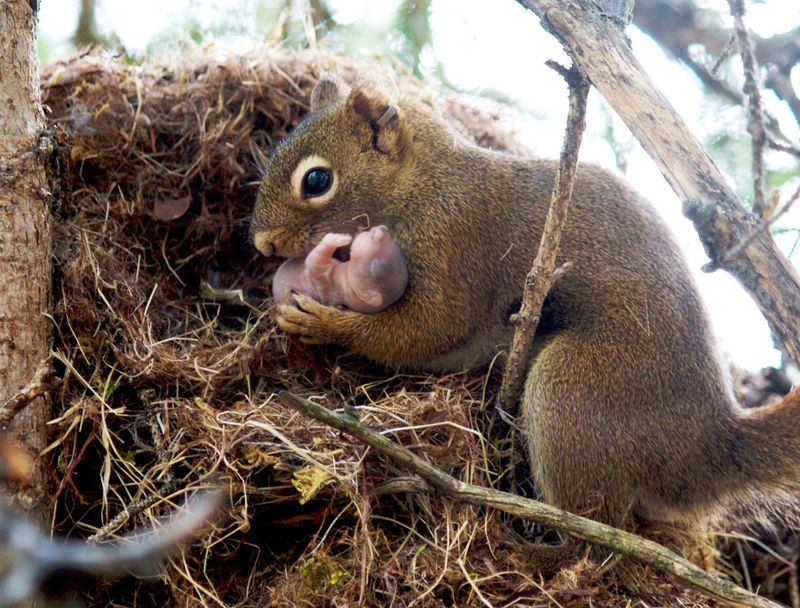When you’re walking through your yard or hiking in the woods around West Virginia, spotting what looks like a bird’s nest high up in a tree seems normal enough. But sometimes, that clump of leaves or strange round shape isn’t a nest at all.
Understanding what else might be hanging in your trees can help you identify wildlife, protect your property, and appreciate the fascinating creatures sharing your space.
1. Squirrel Dreys Look Deceptively Nest-Like
Gray squirrels build leafy homes called dreys that many people mistake for bird nests throughout West Virginia. These basketball-sized bundles sit wedged in tree forks or against trunks, constructed from leaves, twigs, and bark strips.
Unlike bird nests, dreys are much larger and have a rounded, messy appearance. Squirrels often build multiple dreys across their territory for sleeping, raising young, and escaping predators.
During winter, these structures become more visible when deciduous trees lose their foliage. Spotting one means squirrels are actively using your trees as their neighborhood headquarters.
2. Galls Are Plant Growths, Not Animal Homes
Strange round balls growing on branches might look like insect nests, but they’re actually galls—abnormal plant growths triggered by insects, mites, or fungi. Oak trees across West Virginia commonly develop these peculiar formations.
Gall wasps lay eggs inside tree tissue, causing the plant to form protective chambers around the developing larvae. These structures provide food and shelter for the insects inside.
Most galls won’t harm your trees significantly. They come in various shapes: round balls, spiky clusters, or fuzzy bumps, each created by different species with fascinating life cycles.
3. Bagworm Cases Dangle Like Tiny Ornaments
Those small, cone-shaped sacks dangling from your evergreens aren’t decorations—they’re bagworm cases. These caterpillars construct protective shelters from silk and bits of the host plant, creating camouflaged homes.
Bagworms can seriously damage trees in West Virginia, especially arborvitae, juniper, and spruce. The larvae feed on foliage while remaining hidden inside their portable cases.
Each bag contains either a feeding caterpillar or, later in the season, hundreds of eggs waiting to hatch. Removing these cases by hand during winter prevents next year’s infestation effectively.
4. Bald-Faced Hornet Nests Command Respect
That massive gray, papery sphere hanging from a branch belongs to bald-faced hornets, and it definitely isn’t something to mess with casually. These aerial nests can grow as large as basketballs by late summer.
Hornets chew wood fibers and mix them with saliva to create their distinctive paper nests. Colonies can contain hundreds of aggressive defenders ready to protect their queen and developing young.
In West Virginia’s forests and yards, these nests appear most commonly in late summer. Keep your distance—these insects will vigorously defend their home if they feel threatened by curious humans.
5. Witches’ Broom Creates Tangled Branch Clusters
Dense, tangled masses of branches sprouting from one spot create what’s called a witches’ broom. Fungi, mites, viruses, or genetic mutations cause this bizarre growth pattern across many West Virginia tree species.
These clusters look like abandoned nests or strange bundles of sticks jammed into the canopy. The abnormal growth results from disrupted hormones that cause excessive branching in a concentrated area.
While visually striking, most witches’ brooms don’t kill trees. They simply add character and mystery to the forest, sparking curiosity among hikers who notice these peculiar formations overhead.
6. Mistletoe Clumps Parasitize Host Trees
Those evergreen clumps staying green while everything else goes bare might be mistletoe, a parasitic plant that taps into tree branches for water and nutrients. Several species grow wild throughout West Virginia’s forests.
Mistletoe sends root-like structures called haustoria into the host branch, stealing resources while photosynthesizing its own food. Birds spread the sticky seeds from tree to tree after eating the berries.
Heavy infestations can weaken trees over time, though a few clumps usually won’t cause serious harm. The holiday tradition comes from these very same plants growing naturally overhead.
7. Tent Caterpillar Webs Spread Across Branches
Silky white webs stretched across branch forks signal tent caterpillars have moved into your trees. Eastern tent caterpillars are common spring visitors to West Virginia, building communal shelters where they rest between feeding sessions.
These caterpillars emerge in early spring, spinning silk tents that expand as the colony grows. They venture out to eat leaves, then return to their protective web for safety.
While unsightly, tent caterpillars rarely kill healthy trees. The webs distinguish themselves from bird nests by their irregular, gauzy appearance and the presence of numerous crawling caterpillars nearby.








